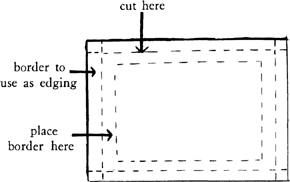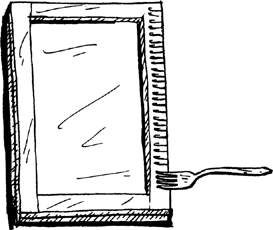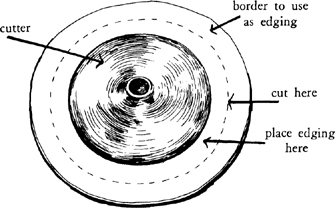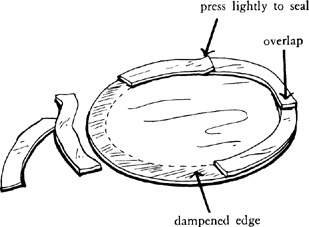Mastering the Art of French Cooking, Volume 2 (194 page)
Read Mastering the Art of French Cooking, Volume 2 Online
Authors: Julia Child

To make a square or rectangular shell
Sufficient chilled puff pastry dough
A ruler or light-weight baking sheet to use as a cutting guide
A ravioli wheel or sharp knife
A baking sheet rinsed in cold water but not dried
A cup of cold water and a pastry brush
Roll out the chilled pastry 1½ inches larger than the size you want your tart to be. With cutting guide and ravioli wheel or knife, trim off rough edges all around.
Again using your guide and ravioli wheel or knife, |
|
| Paint top circumference of tart with a ¾-inch strip of cold water. Lay a strip of pastry on top of each side, as shown. Paint corners with cold water, and lay two final strips of pastry over each end. Trim off excess. |
(*) When chilled and firm, dough may be wrapped airtight and frozen for several months; continue with whatever your recipe, using dough in its frozen state.
Forming a round tart shell
Using
vol-au-vent
cutters, pot lids, or any convenient circular objects, pick one for the size of your eventual tart and another ¾ inch larger all around for the raised rim of the tart. Roll out pastry ⅛ inch thick and ¼ inch larger all around than the larger of your two cutting guides; lift pastry and let it shrink if it will, and extend again if necessary. Center guide on pastry and cut off excess dough.
Center the smaller guide in the pastry and cut all around it cleanly, so that this center disk can easily separate itself from the outside circle. |
|
| Paint a ¾-inch strip around the circumference of disk with cold water. Lay one of the strips of dough in place on the dampened circumference of disk, and paint one end of strip with cold water. |
Baked shells for fresh fruit tarts, like strawberries






